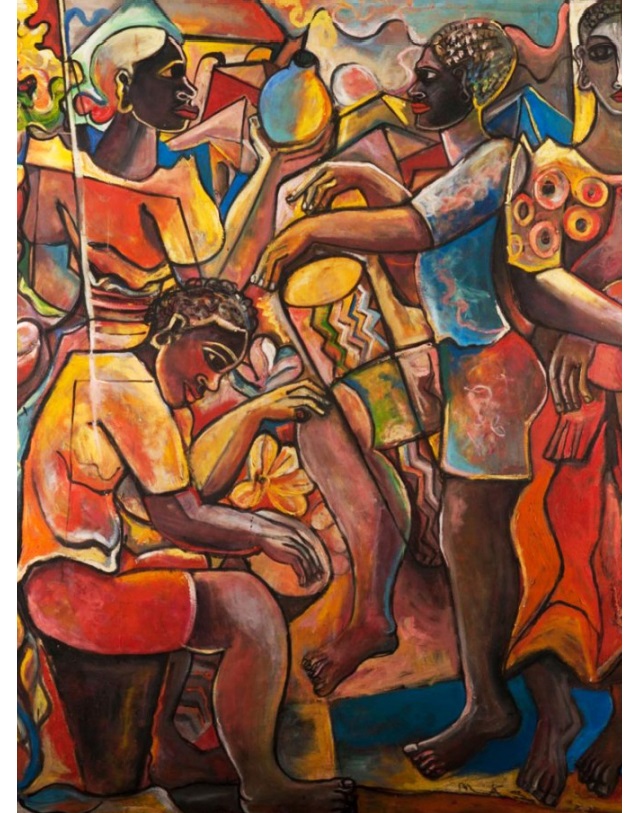
“Referencing the work of others shows an awareness of self and others”
Kampala, Uganda | DOMINIC MUWANGUZI | The influence of Western modern art on Modern and Contemporary art from Uganda is has always been visible. . In the past artist like Geofrey Mukasa (RIP) where much inspired by western modernist artists like Pablo Picaaso in both technique and imagery. Mukasa, a graduate from Lucknow University, India, was influenced by Pablo Picasso’s cubist style of painting that involved dismantling of objects on canvas and re-arranging them. Mukasa adopted also the Mask motif that pervades many of Picasso’s paintings and drawings we see today.
This resemblance in style and technique is invoked in painting like Celebration where Mukasa emphasized the representation of natural forms- the human figure and artificial objects in this case-as geometric shapes seen from several angles. He evoked also the mask in the human figures in the painting. This approach, injected it with an intelligent artistic quality. It is only an artist who has made research and study on Picasso that can come up with such a timeless composition.
Celebration also conjures the aspect of linking traditional art forms to the modern and contemporary art forms. The painting’s composition of two nubile women dancing the traditional Gganda dance with the company of two male drums (Ngalabi) being drummed by two lads evokes the traditional Buganda culture where Mukasa belonged to. This painting captures the mood of festivities in many Buganda households.
Henry Mzili Mujunga’s previous series of paintings on Head, 2013 and Eria Sane Nsubuga’s painting of Christ at Golgotha (Undated) are similarly influenced by the West. Mzili a conceptual and indigenous Expressionist artist mounted an exhibition of Dick Head and Scatter Heads at Afriart gallery in April 2014. The concept of working with the Head as a subject matter reminded many art critics to Oliver Cromwell’s drawings of the head on spikes that were a metaphor to the authoritarian nature of the aristocrats.
The Dick heads and Scatter heads according to Mzili are a figurative representation of the West’s notorious attitude to the continent’s problems. While attempting to solve our problems in form of advancing aid, the West imposes totalitarian laws in form of trade restrictions and promoting cultural imperialism. On the other hand, he derides African regimes for their rubber stamp legislations that allow such social ills to go on uncheck.
In his essay, ‘Reflections on the Head’, responding to the series of artworks by Mzili, Samson Xenson Ssenkaaba interpreted Mzili’s Head exhibition as an allusion to the question of identity, strength and relevance of the African in an increasingly globalized village.
“They remind me of images of negritude by the black painters of the 70s who were conscious commentators on social ills such as racism, segregation and police brutality at the same time highlighting African American pride,” Xenson wrote.
The eclectic artist went on to evoke the intellectual and aesthetic value of the Head as “deeply rooted and inspired by the masks which have a historical, cultural and spiritual significance in ancestral African traditions.”
According to the artist, the work also evoked elements of solitude and abandonment brought about by the cliché of what constitutes African art by Art world gate keepers. These seem to be oblivious to Africa’s contribution to the global art world discourse.
On his part, Eria Sane Nsubuga an artist who juxtaposes art and academic studies said that referring to the work of others shows an awareness of self and others. “It is therefore natural given the residual western political and educational set up for African artists to refer to the work of the European masters that we saw in the Art History books. Incidentally those same books as a matter of design more than accident, said nothing about our own indigenous art.” he quoted in his essay, ‘Dead men tell no tales’.
Eria’s article hinged on biblical analogies validates the influence of western art history on African traditional art by explaining the need to court western art tools like language, dictum, art methods and philosophies in order to check the gross imbalance in the flow of ideas. In essence, the artist was of the view that looking to the west for inspiration in art makes the artist’s work potent in a global world we are living in today.
****
Part of this article first appeared in Starjjournal.org. Images courtesy of Startjournal.org
 The Independent Uganda: You get the Truth we Pay the Price
The Independent Uganda: You get the Truth we Pay the Price



